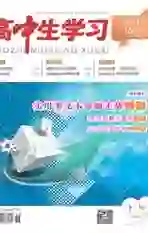状语从句从属连词易错剖析
2016-05-14张涛王锋
张涛 王锋
状语从句是英语语法的重点,也是历年高考的常考点。高考对它的考查主要体现在七选五阅读、语法填空和短文改错等题型中。状语从句的考查重点是从属连词用法的辨析、主从句时态的呼应及状语从句的倒装等。本文以高考真题为例,剖析状语从句的从属连词这一考点,以期帮助同学们探索解题技巧,加强对状语从句语法基本知识和技能的掌握,从而提高应试能力。
[时间状语从句] [1]
例1 I had hardly got to the office _______ my wife phoned me to go back home at once.
答案 when。
分析 本题考查的是hardly ... when或scarcely ... when引导的时间状语从句。有的同学可能会误填before。原因是他们只注意到空格前后两个分句之间的关系,而没有注意到这是一种表示时间的固定句型。
例2 He had no sooner finished his speech _______ the students started cheering.
答案 than。
分析 本题考查no sooner ... than ...“一……就……”句型。
点拨 时间状语从句中表示“一……就……”的方式很多,此例属于no sooner ... than ..., hardly ... when ..., scarcely ... when ...这种句式。针对此结构,同学们要注意以下几点:①它们只能表示过去的事情;②no sooner与hardly/scarcely所在的主句的谓语动词应用过去完成时,than与when引导的从句的谓语动词应用一般过去;③当no sooner和hardly/scarcely放在句首时,主句应用倒装形式。如:Hardly had I got home when it began to rain.
例3 Be careful. The moment ________ you press the button, the machine will start.
答案 不填词。
分析 本题考查名词当连词用,引导时间状语从句的用法。有的同学易误填when。
点拨 在英语中,有些特殊的名词或副词可以起连词的作用,直接引导时间状语从句。这时,复合句中不需要添加任何连词。能这样用的名词有:the moment,the minute,the instant/the second/each/every time,next time等;能这样用的副词有:immediately,directly,instantly等。由这些名词或副词引导的时间状语从句,相当于as soon as引导的时间状语从句。常译为“一……就……,刚……就……”。
例4 The young couple, who returned my lost wallet, left _______ I could ask for their names.
答案 before。
分析 根据语境可知,作者在问他们名字之前,他们已经走了。故填before。有的同学容易把before引导的时间状语与从属连词when或since等混淆。
点拨 before引导的时间状语从句,翻译比较灵活。若表达“还未……就……;不到……就……;……才……;还没来得及……就……”时,需用连词before。如:We had sailed four days and four nights before we saw land. 我们航行了四天四夜,才看到陆地。We hadnt run a mile before he felt tired. 我们跑了还不到一英里,他就累了。此外,before还常用于“it will be+一段时间+before ...”(多久之后才……)这个句型。
[用于并列句中的连词when] [2]
例5 On Friday, we were packing to leave for a weekend away _______ my daughter heard a cry for help.
答案 when。
分析 有的同学可能会误填and。原因是他们只注意到空格前后两个分句是并列关系,却忽视了前句提供的语境。此题考查的是when用作并列连词,引导并列句。
点拨 此例中when的意义为“就在这时”,等同于and then/just at that time。同学们不要把它理解为“当……的时候”。when前面的逗号可有可无,类似的用when的句型有:
①was/were doing something ... when ...意为“正在干什么……,这时突然……”;②was/were about to do something ... when ...或was/were on the point of doing something ... when ...意为“正要干某事……,这时突然……”;③had just done something ... when ...意为“刚刚做完什么……,这时突然……”。同学们一定要牢记连词when用于并列句中的这几种句型结构。
[ it+be+时间+since/before/that/when ...句型] [3]
例6 As is reported, it is 100 years _______ Tsinghua University was founded.
答案 since。
分析 这里用句式“it is/has been+一段时间+since引导的时间状语从句”,表示“自从……(到现在)有多长时间了”。有的同学易填before,that或when,原因可能是他们将句子理解成了强调句或是before/when引导的时间状语。
例7 It was when we were returning home _______ I realized what a good feeling it was to have helped someone in trouble.
答案 that。
分析 句意:正当我们回家的时候,我意识到帮助处于困境中的人的感觉是多么好。本题考查强调句型“it is/was+被强调部分+that/who+其他成分”。本句中被强调部分是when we were returning home,故用that。部分同学容易误填before/when等。
例8 It was the middle of the night _______ my father woke me up and told me to watch the football game.
答案 when。
分析 本题有的同学易误填that/before。原因可能是他们没有理解语境。根据设空处应缺少一个连词,引导时间状语从句,表示“当……的时候”,故填when。
点拨 在“it+be+时间+since/before/that/when ...”句型中,连词的选择应根据以下规则:
用when时,则以具体的时间为节点,如:two oclock等,意为“当……时……,是什么时间”;
用since时,意为“自从……以来已多久了”;
用that且句中的“时间”作时间状语时,句子是强调句,将it is/was ... that去掉后,句子仍完整;
“it is/was+时间段+before”从句,表示“过了多久才……”,要求前后时态一致;
“it is+时间+since”从句,要求从句谓语动词为非延续性动词的过去式,be动词用is。
如果从句的谓语动词是延续性动词,常译成否定的意思。如:It is two years since Mr. Green smoked. 格林先生已经戒烟两年了。
[让步状语从句易错点] [4]
例9 Hot _______ the night air was, we slept deeply because we were so tired after the long journey.
答案 as/though。
分析 有的同学易误用although, 因为他们可能仅注意到了前后两句话之前的让步关系。但although引导的让步状语从句不能用倒装形式。
点拨 although引导让步状语从句,从句不用倒装形式。由as引导的让步状语从句必须倒装,而由though引导的让步状语从句可以倒装。这种倒装的结构是“n./adj./adv./v.+as/though+主语+谓语”。如果从句的表语是名词,当表语被置于as/though之前时,既使其前有形容词修饰,也不用冠词。如:Pop star as/though she is, she still needs to improve.
例10 Although the job takes a significant amount of time, _______ most students agree that the experience is worth it.
答案 不填。
分析 有的同学易受汉语“虽然……但是”句式的影响,而在横线上填but。
点拨 though和although两个词都有“虽然”“尽管”之意,在引导让步状语从句时,都不能与but连用,但可以与yet或still连用。although与though相比,前者显得比较正式,引导的从句多用于主句之前。而由though引导的从句既可以放在主句之前,也可以放在主句之后。此外though还可作副词,意为“可是,然而”,置于句末。如:Li Ping works very hard at his lessons. He didnt get the first place in the exam, though. 而although无此用法。
例11 _______ one of you breaks the window will have to pay for it.
答案 Whichever。
分析 此句是一个名词性从句,而不是状语从句。有的同学认为“疑问词+ever”等于“no matter+疑问词”,很可能会误填No matter which。
例12 To show our respect, we usually have to take our gloves off _______ we are to shake hands with.
答案 whoever/no matter who。
分析 由句意知,空格处应意为“无论我们与谁握手”,设空处引导让步状语从句。we are to shake hands with后缺少宾语,并且指“人”,故用whoever/no matter who引导。
点拨 “疑问词+ever”,如however/whatever/whoever/wherever/whenever/whichever等既可以用于让步状语从句,又可用于名词性从句。而“no matter+疑问词”构成的词,如:no matter how/no matter what/no matter which/ no matter who/no matter where等,只能引导让步状语从句。
[条件状语从句] [5]
例13 I believe you will have a wonderful time here _______ you get to know everyone here.
答案 if/once。
分析 此句考查的是条件状语从句。此句大意为:我相信:如果/一旦你认识了其他所有的人,你会在这里玩得很开心。根据句意和语境可知用if/once。部分同学可能会误填unless。
例14 It is so cold that you cant go outside _______ fully covered with in thick clothes.
答案 unless。
分析 此句考查条件状语从句。根据句意和语境可知,此处应该是表达外出的条件,即:穿了厚衣服才能外出,不穿厚衣服不能外出。unless=if ... not,此句用的是双重否定表示肯定的意思。另外,此句用了状语从句的省略。句中unless fully covered在这里等于unless you are fully covered。
点拨 引导条件状语从句的从属连词有if(如果;假设),unless=if ... not(除非),so/as long as(只要),in case(如果),on condition that(在……条件下),suppose/supposing (that)(假设), providing/provided that(如果)等。同学们要注意unless与if的区别,以防混淆它们的意思或用法。如:She says that shell have to close the shop _______ business improves. 此句条件为business doesnt improve,故用unless。
此外,同学们还要注意状语从句的省略现象。当状语从句的主语和主句的主语一致,且从句的谓语部分含be动词时,可以省略状语从句的主语和be动词。如:Work hard when (you are) young, or youll regret. 当从句的主语是it,谓语部分中又含有系动词be时,可以把it和be一起省略。构成“连词(if/unless/when/whenever等)+形容词”的结构。如:Make a careful plan if (it is) possible.
[结果状语从句] [6]
例15 It was _______ fine weather that they all went swimming.
答案 such。
分析 此句是一个结果状语从句。fine weather的中心词是名词,根据语法规则,such是形容词,它用来修饰名词或放在系动词后面。而so是副词,它用来修饰形容词、副词或动词。当名词前有mnay/much/little/few 等修饰时,用so不用such。有的同学可能只注意到了形容词fine,而忽视了fine weather的中心词是weather,而误填so。
点拨 引导结果状语从句的从属连词有so that, so ... that ...,such ... that ...。它们的结构分别为:
so+形容词/副词+that从句;
so+形容词+a/an+可数名词单数形式+that从句;
so+many/much/little/few+名词+that从句;
such+a/an+形容词+可数名词单数形式+that从句;
such+形容词+复数名词/不可数名词+that从句;
such+a lot of/lots of+that从句。
当so或such以及所修饰的部分置于句首时,主句要用倒装语序。如:So clever a student was he that he was able to work out all difficult problems.
